Enhanced Design of Sunroof System through Parametric Study Considering Vibration Phenomenon during Vehicle Operation
Abstract
:1. Introduction
1.1. Research Background
1.2. Related Literature
1.3. Objectives
2. Thin Plate Theory
3. Vibration Measurement and Analysis
3.1. Experimental Setting
3.2. Experimental Modal Analysis (EMA)
3.3. Operational Deflection Shape (ODS)
4. Numerical Modal Analysis
4.1. Background
4.2. Model Setting and Conditions
4.3. Modal Analysis Results for the Base Model
4.4. Modal Analysis According to Changes in Design Factors
5. Conclusions and Future Research Directions
- -
- Young’s modulus variation:
- -
- Glass thickness alteration:
- -
- Bracket position adjustment:
- (1)
- Experimental work for vibration measurements of the whole vehicle were conducted “during operation” with the sunroof system installed, while prior investigations were constrained to examining the static rigidity of a single part.
- (2)
- An effort was undertaken to establish reliability among different methodologies through a comparison of theoretical, analytical, ODS, and EMA results.
- (3)
- On this basis, parametric study-based optimization process is conducted, and it is confirmed that an optimal design is feasible to reduce the vibration of the vehicle sunroof that occurs while the vehicle is in motion.
Author Contributions
Funding
Institutional Review Board Statement
Informed Consent Statement
Data Availability Statement
Conflicts of Interest
References
- Ha, J.; Choi, S.; Jeon, B.; Ra, M.; Jeong, S. Reliability Evaluation for Tubeless Frame System of the Sunroof on the Car Body. In Proceedings of the KSAE 2015 Annual Conference and Exhibition, Gyeongju, Republic of Korea, 18 November 2015. [Google Scholar]
- Lee, K.H.; Kim, C.M.; Kang, Y.K. An Optimal Placement of Passive Constrained Layer Damping Treatment for Vibration Suppression of Automotive Roof. J. Korean Soc. Noise Vib. Eng. 2004, 11, 349–353. [Google Scholar]
- Choi, G.; Shin, D.; Choi, S.; Jeong, S. A Study on the Structural Analysis of Automotive Sunroof System. In Proceedings of the KSAE 2015 Annual Conference and Exhibition, Gyeongju, Republic of Korea, 18 November 2015. [Google Scholar]
- Hwang, J.D.; Cho, S.J.; Kim, C.S.; Kang, S.H. A Study on the Vibration Test and Analysis for the Sun Shield Roof of Heavy Construction Equipment. In Proceedings of the Korean Society of Precision Engineering Conference, Jeju, Republic of Korea, 31 May 2012. [Google Scholar]
- Ha, J.; Choi, S.; Jeon, B.; Ra, M.; Jeong, S. Optimum Structural Design Tubeless Frame System of the Sunroof on the Car Body. In Proceedings of the KSAE 2015 Spring Conference and Exhibition, Gwangju, Republic of Korea, 31 May 2015. [Google Scholar]
- Woo, J.; Jeong, H. Design for load of improvement panorama sunroof. In Proceedings of the KSAE 2016 Annual Conference and Exhibition, Daegu, Republic of Korea, 16 November 2016. [Google Scholar]
- Kim, I.; Lee, S.; Heo, S.J.; Jeong, J.I. A Study for Evaluation Method of Sunroof System’s Structural Performance. In Proceedings of the KSAE 2010 Annual Conference and Exhibition, Daegu, Republic of Korea, 24 November 2010. [Google Scholar]
- Kim, H.; Kang, Y.; Park, H. Identification of Dynamic Characteristics of Vehicle Parts using Experimental Modal Analysis. In Proceedings of the KSAE 2019 Spring Conference and Exhibition, Jeju, Republic of Korea, 9 May 2019. [Google Scholar]
- Choi, S.; Song, Y.; Lee, J.; Seo, S.; Kang, H. Dynamic Characteristic Analysis of the Park Lock Wheel Using Mode Analysis and Modal Testing. In Proceedings of the Korean Society of Mechanical Engineers Conference, Taebeak, Republic of Korea, 14 December 2016. [Google Scholar]
- Lee, J.M.; Yu, H.T.; Park, G.J.; Choi, H.C.; Choi, B.H. Design for Resonance Avoidance of Mount Though the Modal Analysis. J. Korean Soc. Noise Vib. Eng. 2015, 25, 481–486. [Google Scholar]
- Huang, H.; Zhang, Y.; Sui, H. Design Strategy for Fixed Sunroof System; American Society of Mechanical Engineers Digital Collection: Lawrence, KS, USA, 2021. [Google Scholar]
- He, Y.; Zhang, Q.; An, C.; Wang, Y.; Xu, Z.; Zhang, Z. Computational Investigation and Passive Control of Vehicle Sunroof Buffeting. J. Vib. Control 2020, 26, 747–756. [Google Scholar] [CrossRef]
- Riedelsheimer, A.; Maihöfer, M. Experimental and Numerical Analysis of Sunroof Buffeting of a Simplified Mercedes-Benz S-Class. SAE Int. J. Adv. Curr. Prac. Mobil. 2021, 4, 387–397. [Google Scholar] [CrossRef]
- He, Y.; Zhang, Q.; Xu, Z.; Zhang, Z. Study on the Sunroof Buffeting Suppression with a Notched Flat Deflector. INTER-NOISE NOISE-CON Congr. Conf. Proc. 2019, 259, 1677–1683. [Google Scholar]
- Zhang, Q.; He, Y.; Wang, Y.; Xu, Z.; Zhang, Z. Computational Study on the Passive Control of Sunroof Buffeting Using a Sub-Cavity. Appl. Acoust. 2020, 159, 107097. [Google Scholar] [CrossRef]
- Tang, R.; He, H.; Lu, Z.; Li, S.; Xu, E.; Xiao, F.; Núñez-Delgado, A. Control of Sunroof Buffeting Noise by Optimizing the Flow Field Characteristics of a Commercial Vehicle. Processes 2021, 9, 1052. [Google Scholar] [CrossRef]
- Li, S.; Lu, Z.; Tang, R.; Xu, E.; Feng, Z.; Li, G. Optimization of Wind Resistance in Commercial Vehicles with Consideration of Sunroof Buffeting Noise. AIP Adv. 2021, 11, 085304. [Google Scholar] [CrossRef]
- Vijaykumar, K.; Poonkodi, S.; Sriram, A.T. Numerical Study on Control of Sunroof Buffeting. Int. J. Veh. Struct. Syst. 2021, 13, 256. [Google Scholar] [CrossRef]
- Lee, S.W.; Shin, S.; Choi, E.S.; Yi, J. Analysis of flow characteristics around the sunroof opening variation with sunroof deflector angle. J. Acoust. Soc. Korea 2018, 37, 285–291. [Google Scholar] [CrossRef]
- Demori, D.; Oliveira, M.P.D.; Viegas, R.; França, D.; Neto, O.T. Buzz Avoidance on Sunroof Light Sunshades: Design and Validation; SAE International: Warrendale, PA, USA, 2020. [Google Scholar]
- Nandagiri, R.; Kumar, S.S.; Nagrale, P.; Chaure, V.; Chormare, S.; Chandrikapure, A.; Sahoo, D. Computational Analysis for Optimal Location of Open Sunroof for an SUV with Ahmed Body Profile. AIP Conf. Proc. 2023, 2890, 020004. [Google Scholar] [CrossRef]
- Cao, S.; Zhang, Z.; Zhang, Q.; Xu, Z.; Lin, W. Energy Transfer Characteristics of Sunroof Wind Buffeting Noise via Dynamic Mode Decomposition. J. Sound Vib. 2023, 555, 117724. [Google Scholar] [CrossRef]
- Inman, D.J. Engineering Vibration, 3rd ed.; Pearson: Upper Saddle River, NJ, USA, 2008. [Google Scholar]
- Reismann, H. ELASTIC PLATES Theory and Application, 1st ed.; Wiley-Interscience: New York, NY, USA, 1988. [Google Scholar]
- See, S. Analysis for A Partial Distribution Loaded Orthotropic Rectangular Plate with Various Boundary Condition. J. Korea Inst. Struct. Maint. Insp. 2018, 22, 13–22. [Google Scholar]
- Yang, M.; Jeong, S.M.; Lee, S.H.; Lim, J.Y. Experimental Study of Structural Capability Loss of Bolt Clamping Force and Loosening Life of Bolts under Cyclic Loading Conditions. J. Korea Soc. Railw. 2022, 25, 89–95. [Google Scholar] [CrossRef]
- Liu, Z.; Zheng, M.; Guo, J.; Chu, H.; Yan, X.; Li, Y. Experimental study on performance characterization of bolted joint under transverse loading. Measurement 2021, 182, 109608. [Google Scholar] [CrossRef]
- Murata, T.; Tojyo, T. Tempered Glass and Glass for Tempering. U.S. Patent 20160137550A1, 19 May 2016. [Google Scholar]
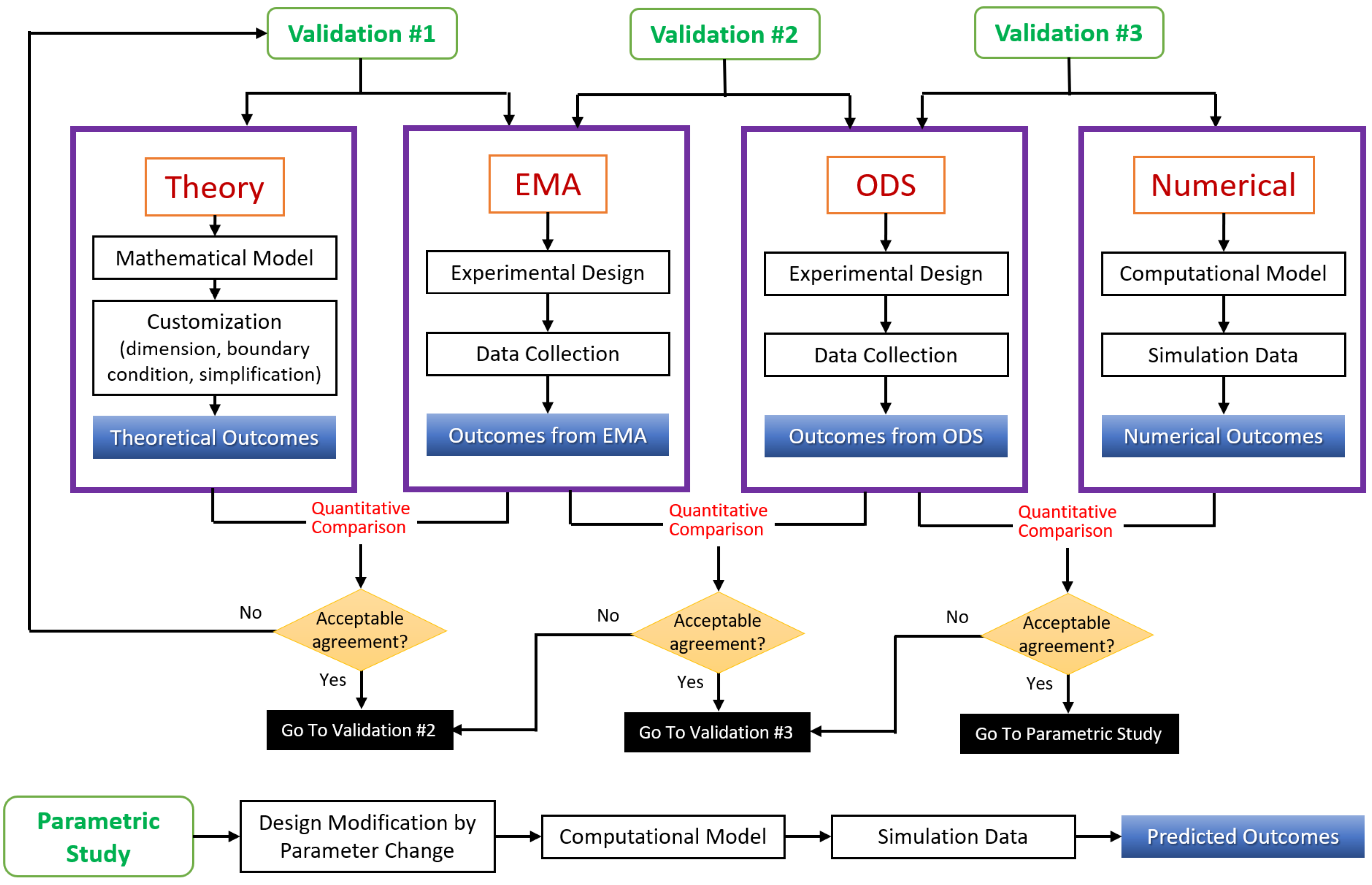

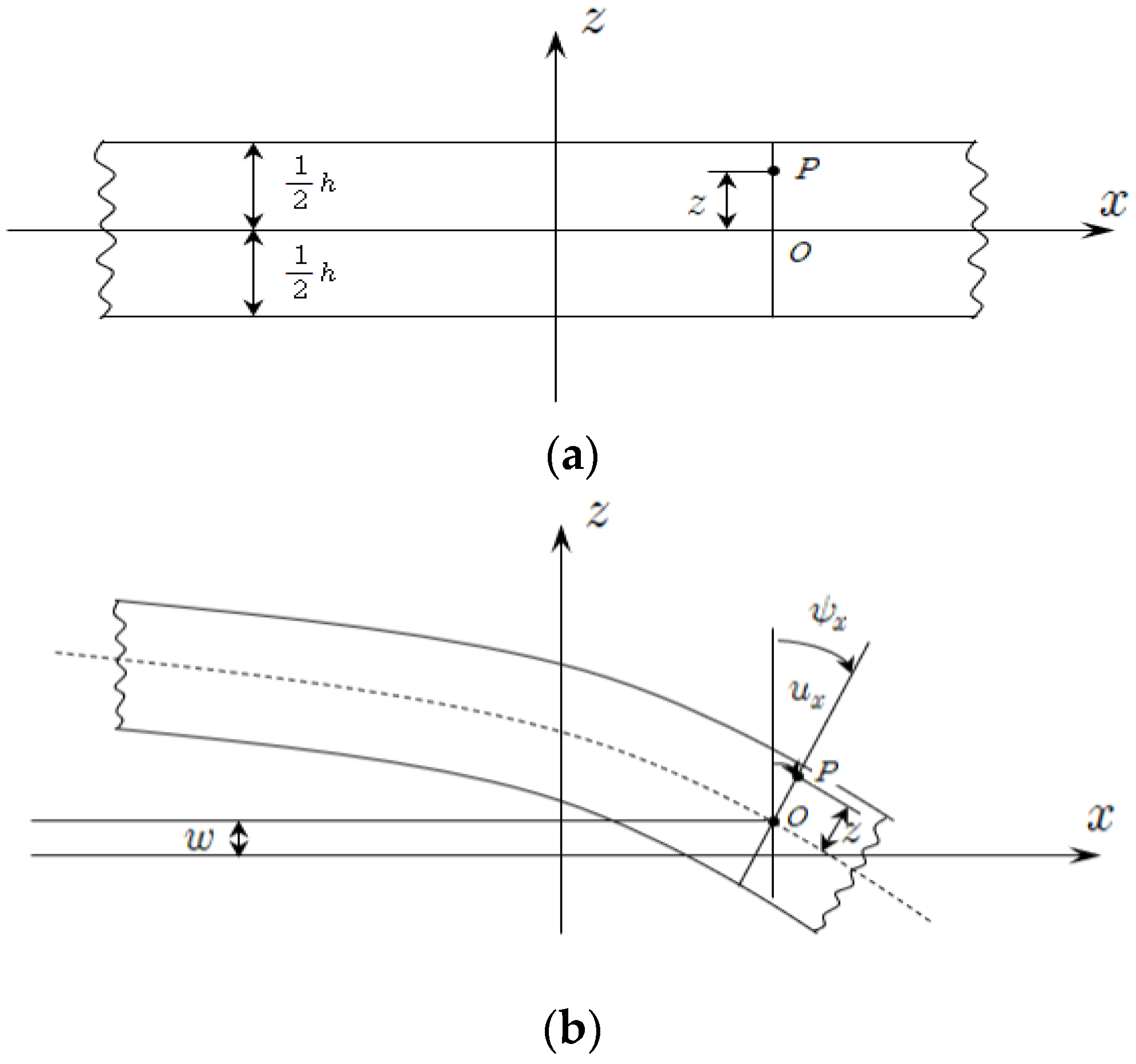

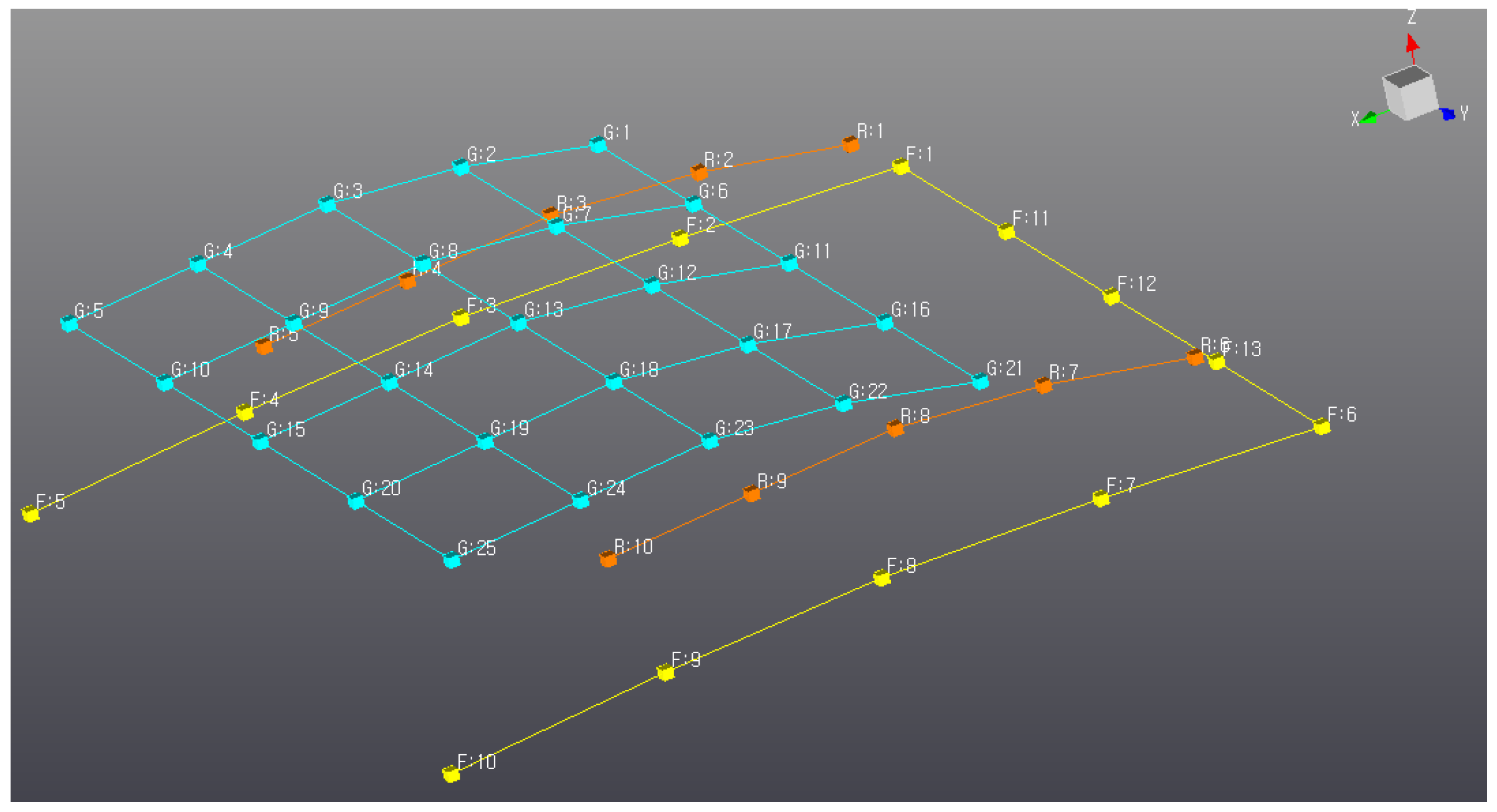

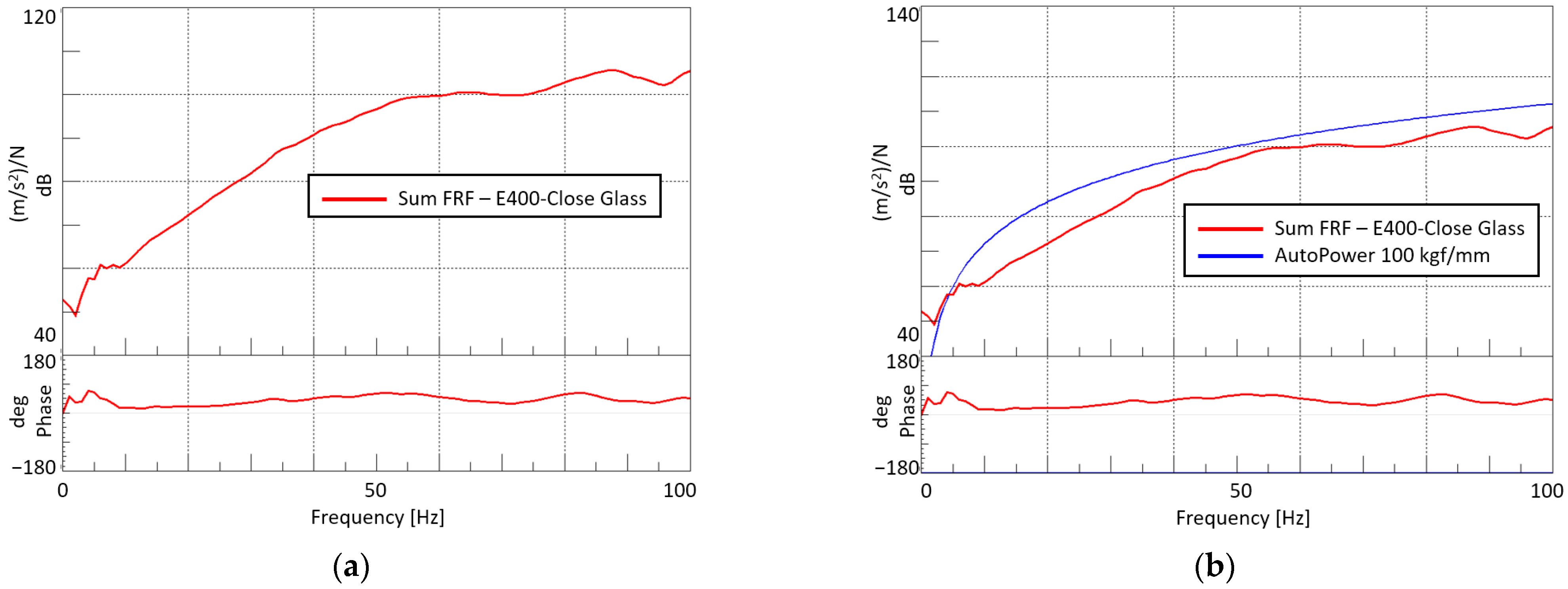

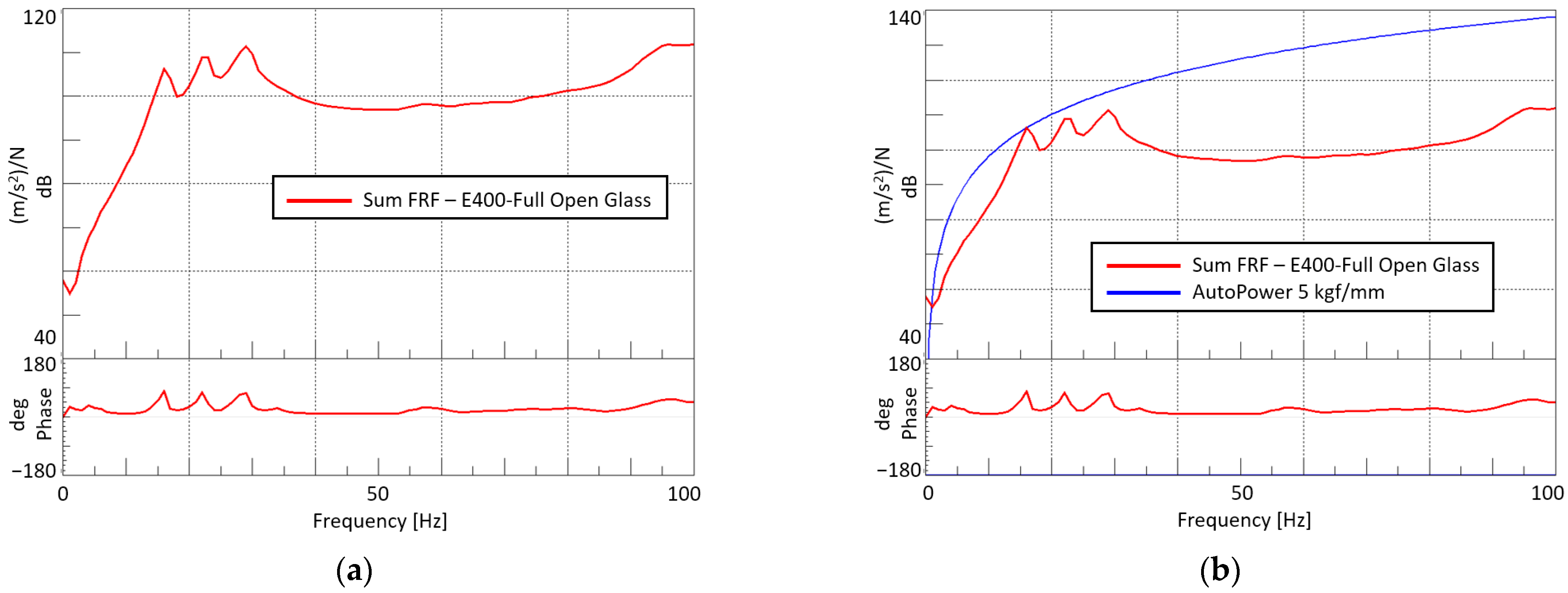

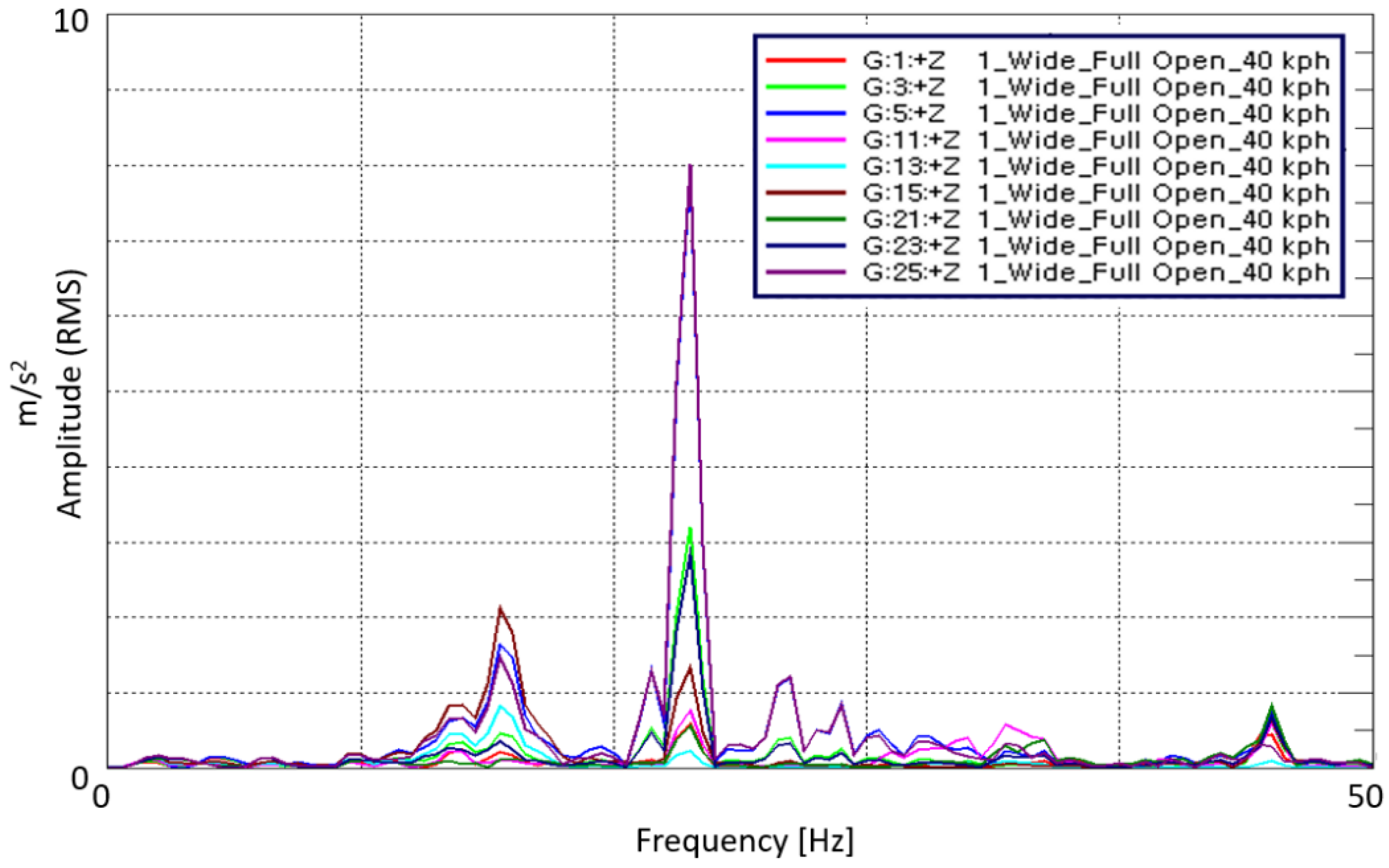



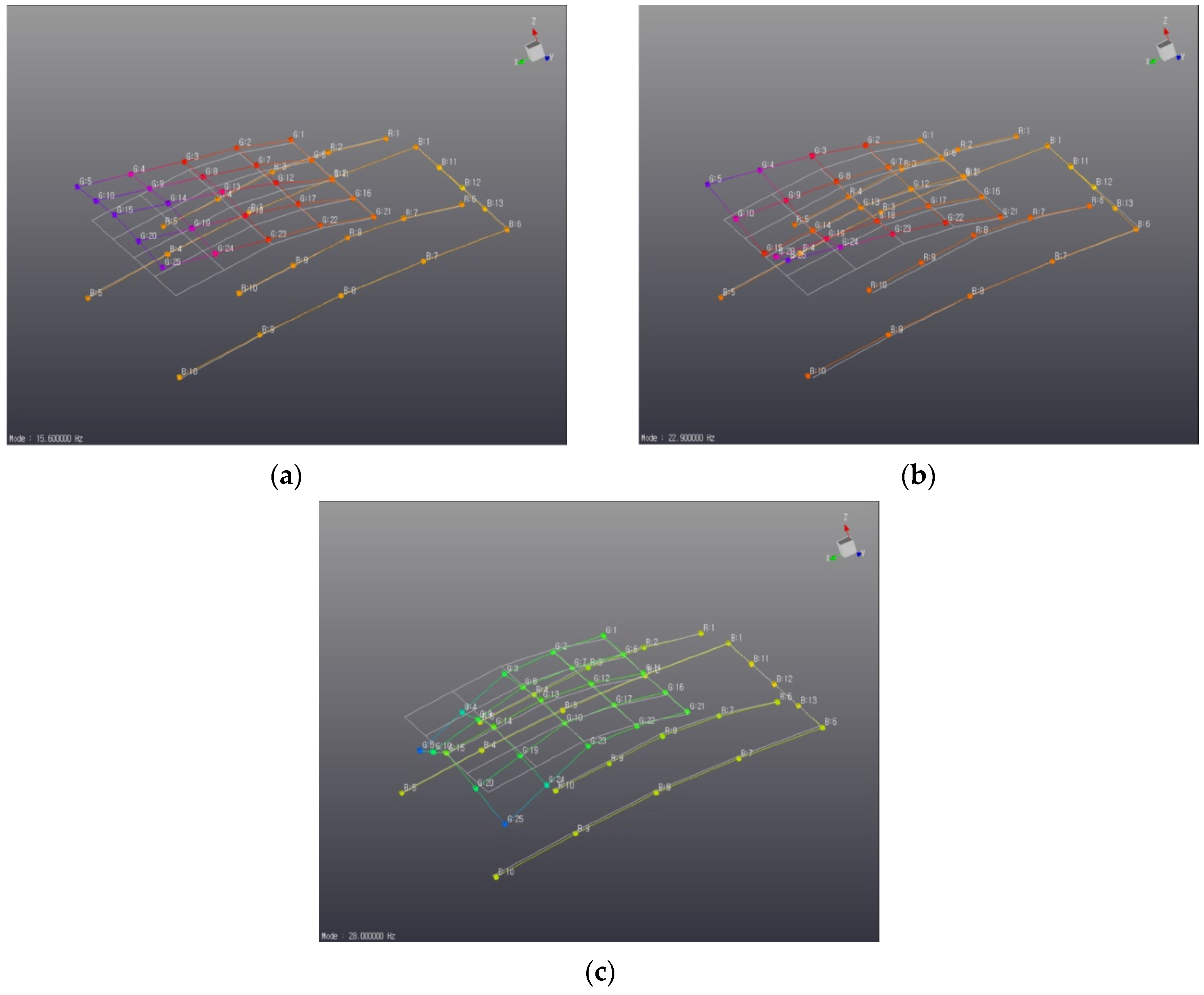





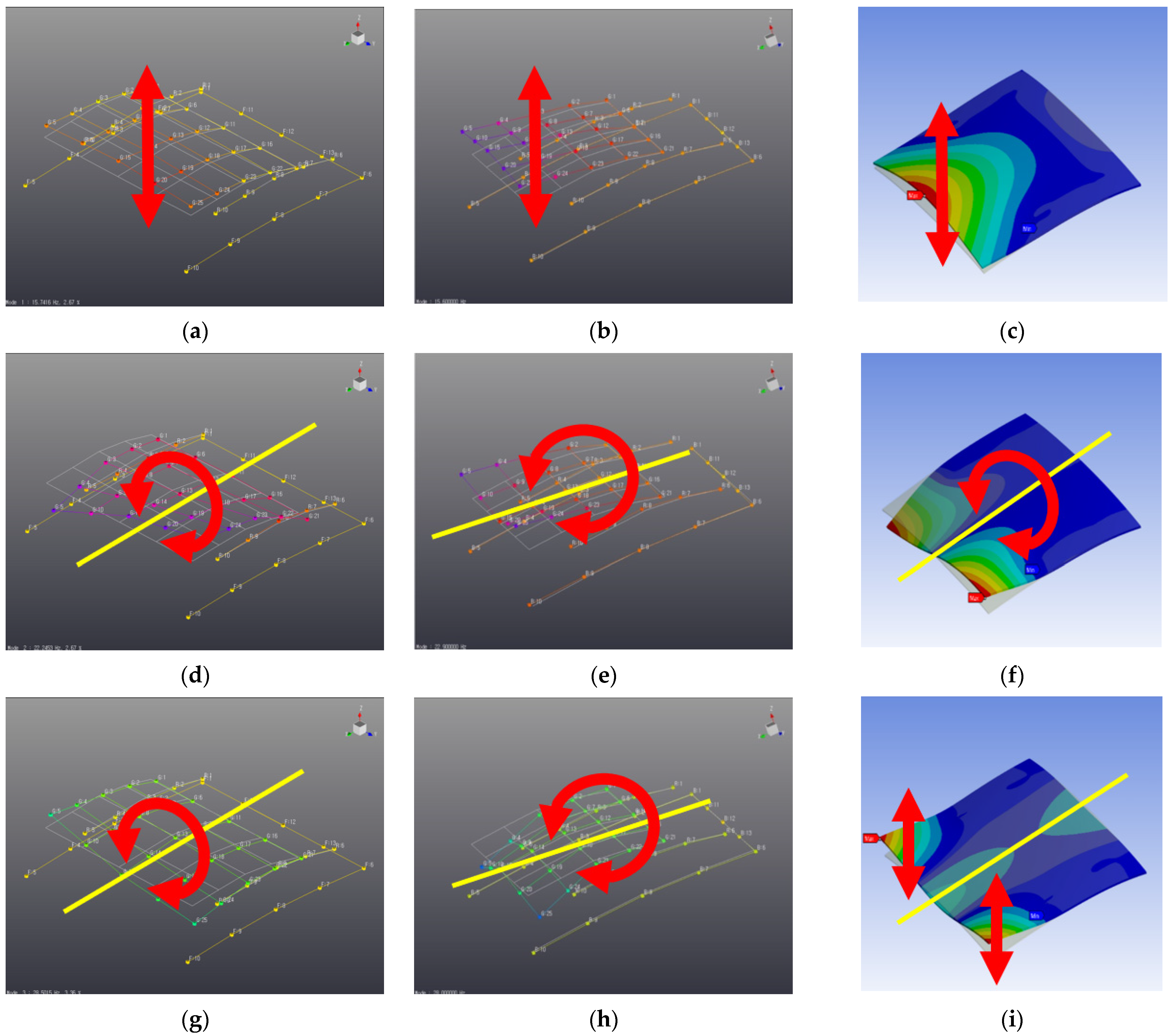
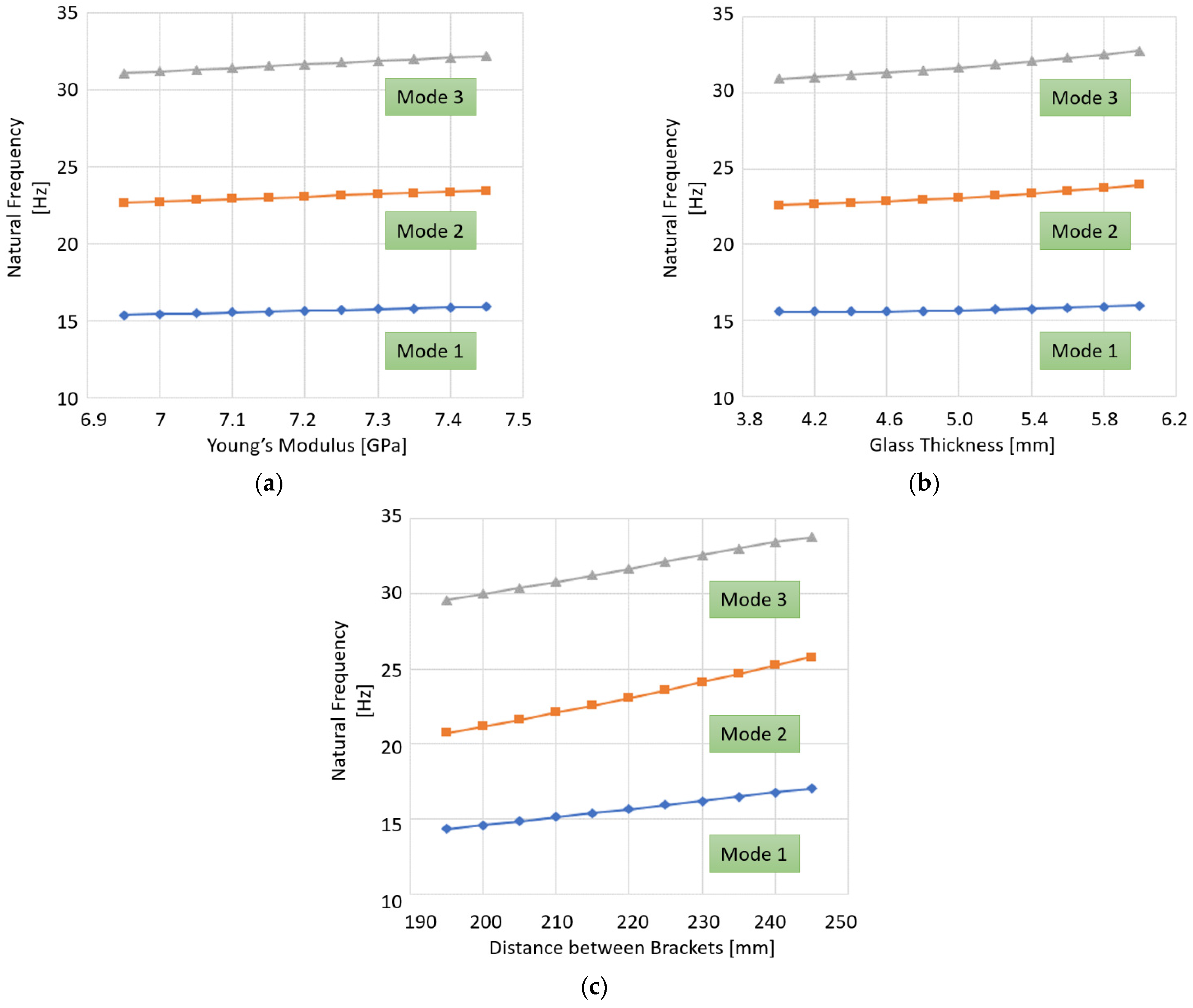
| i | m | n | |
|---|---|---|---|
| 1 | 1 | 1 | 25 |
| 2 | 1 | 2 | 52 |
| 3 | 2 | 1 | 73 |
| 4 | 1 | 3 | 97 |
| 5 | 2 | 2 | 100 |
| 6 | 2 | 3 | 145 |
| 7 | 3 | 1 | 153 |
| 8 | 1 | 4 | 160 |
| 9 | 3 | 2 | 180 |
| 10 | 2 | 4 | 208 |
| 11 | 3 | 3 | 225 |
| 12 | 4 | 1 | 265 |
| i | m | n | ||
|---|---|---|---|---|
| 1 | 1 | 1 | 31.008499 | 8.129787 |
| 2 | 1 | 2 | 49.033996 | 16.909958 |
| 3 | 2 | 1 | 106.008499 | 23.738979 |
| 4 | 1 | 3 | 79.076492 | 31.543575 |
| 5 | 2 | 2 | 124.033996 | 32.519150 |
| 6 | 2 | 3 | 154.076492 | 47.152767 |
| 7 | 3 | 1 | 231.008499 | 49.754299 |
| 8 | 1 | 4 | 121.135986 | 52.030639 |
| 9 | 3 | 2 | 249.033996 | 58.534469 |
| 10 | 2 | 4 | 196.135986 | 67.639831 |
| 11 | 3 | 3 | 279.076492 | 73.168087 |
| 12 | 4 | 1 | 406.008499 | 86.175747 |
| State | Natural Frequency [Hz] | |||||
|---|---|---|---|---|---|---|
| #1 | #2 | #3 | #4 | #5 | #6 | |
| Close | 34.785 | 53.100 | 85.949 | - | - | - |
| Mid-open | 26.490 | 33.830 | 52.011 | 93.802 | - | - |
| Full-open | 15.742 | 22.245 | 28.501 | 33.789 | 56.986 | 95.897 |
| State | Natural Frequency [Hz] | |||
|---|---|---|---|---|
| Theoretical | EMA | Difference | Percentage (%) | |
| #1 | 8.129787 | - | - | - |
| #2 | 16.909958 | 15.742 | 1.168 | 6.907 |
| #3 | 23.738979 | 22.245 | 1.494 | 6.293 |
| #4 | 31.543575 | 28.501 | 3.043 | 9.646 |
| #5 | 32.519150 | 33.789 | −1.270 | 3.905 |
| #6 | 47.152767 | - | - | - |
| #7 | 49.754299 | - | - | - |
| Mode | Natural Frequency [Hz] | |||
|---|---|---|---|---|
| EMA | ODS | Difference | Percentage (%) | |
| #1 | 15.742 | 15.600 | 0.142 | 0.902 |
| #2 | 22.245 | 22.900 | 0.655 | 2.944 |
| #3 | 28.501 | 28.900 | 0.399 | 1.400 |
| Property | Symbol | Unit | Value |
|---|---|---|---|
| Young’s modulus | GPa | 72 | |
| Poisson’s ratio | ν | - | 0.23 |
| Thermal expansion coefficient | α | 9.5 | |
| Tensile strength (float glass) | MPa | 165 | |
| Compressive strength | MPa | 300 | |
| Density | ρ | 2500 |
| Mode | Natural Frequency [Hz] | |||
|---|---|---|---|---|
| ODS | Modal Analysis | Difference | Percentage (%) | |
| #1 | 15.600 | 15.851 | 0.251 | 1.609 |
| #2 | 22.900 | 23.298 | 0.398 | 1.738 |
| #3 | 28.900 | 31.864 | 2.964 | 10.256 |
| Nat. Freq [Hz] | Young’s Modulus (GPa) | |||||
| 7.2 (base) | 7.15 | 7.1 | 7.05 | 7.0 | 6.95 | |
| Mode #1 | 15.673 | 15.619 | 15.564 | 15.509 | 15.454 | 15.399 |
| Mode #2 | 23.069 | 22.989 | 22.908 | 22.828 | 22.747 | 22.665 |
| Mode #3 | 31.632 | 31.522 | 31.411 | 31.301 | 31.189 | 31.078 |
| Nat. Freq [Hz] | Young’s Modulus (GPa) | |||||
| 7.2 (base) | 7.25 | 7.3 | 7.35 | 7.4 | 7.45 | |
| Mode #1 | 15.673 | 15.728 | 15.782 | 15.836 | 15.890 | 15.943 |
| Mode #2 | 23.069 | 23.149 | 23.229 | 23.308 | 23.387 | 23.466 |
| Mode #3 | 31.632 | 31.741 | 31.851 | 31.960 | 32.068 | 32.176 |
| Nat. Freq [Hz] | Glass Thickness [mm] | |||||
| 5.0(base) | 4.8 | 4.6 | 4.4 | 4.2 | 4.0 | |
| Mode #1 | 15.631 | 15.635 | 15.607 | 15.588 | 15.579 | 15.581 |
| Mode #2 | 23.069 | 22.943 | 22.833 | 22.739 | 22.662 | 22.603 |
| Mode #3 | 31.632 | 31.448 | 31.282 | 31.133 | 31.003 | 30.893 |
| Nat. Freq [Hz] | Glass Thickness [mm] | |||||
| 5.0(base) | 5.2 | 5.4 | 5.6 | 5.8 | 6.0 | |
| Mode #1 | 15.673 | 15.721 | 15.777 | 15.842 | 15.915 | 15.995 |
| Mode #2 | 23.069 | 23.211 | 23.369 | 23.541 | 23.727 | 23.928 |
| Mode #3 | 31.632 | 31.830 | 32.043 | 32.268 | 32.503 | 32.746 |
| Nat. Freq [Hz] | Distance between Brackets [mm] | |||||
| 220 (base) | 215 | 210 | 205 | 200 | 195 | |
| Mode #1 | 15.673 | 15.399 | 15.141 | 14.874 | 14.604 | 14.347 |
| Mode #2 | 23.069 | 22.564 | 22.103 | 21.620 | 21.185 | 20.728 |
| Mode #3 | 31.632 | 31.184 | 30.769 | 30.336 | 29.957 | 29.557 |
| Nat. Freq [Hz] | Distance between Brackets [mm] | |||||
| 220 (base) | 225 | 230 | 235 | 240 | 245 | |
| Mode #1 | 15.673 | 15.948 | 16.223 | 16.495 | 16.782 | 17.060 |
| Mode #2 | 23.069 | 23.577 | 24.111 | 24.653 | 25.228 | 25.798 |
| Mode #3 | 31.632 | 32.076 | 32.530 | 32.968 | 33.382 | 33.720 |
Disclaimer/Publisher’s Note: The statements, opinions and data contained in all publications are solely those of the individual author(s) and contributor(s) and not of MDPI and/or the editor(s). MDPI and/or the editor(s) disclaim responsibility for any injury to people or property resulting from any ideas, methods, instructions or products referred to in the content. |
© 2024 by the authors. Licensee MDPI, Basel, Switzerland. This article is an open access article distributed under the terms and conditions of the Creative Commons Attribution (CC BY) license (https://creativecommons.org/licenses/by/4.0/).
Share and Cite
Lee, S.; Kim, B. Enhanced Design of Sunroof System through Parametric Study Considering Vibration Phenomenon during Vehicle Operation. Appl. Sci. 2024, 14, 3085. https://doi.org/10.3390/app14073085
Lee S, Kim B. Enhanced Design of Sunroof System through Parametric Study Considering Vibration Phenomenon during Vehicle Operation. Applied Sciences. 2024; 14(7):3085. https://doi.org/10.3390/app14073085
Chicago/Turabian StyleLee, Simok, and Byeongil Kim. 2024. "Enhanced Design of Sunroof System through Parametric Study Considering Vibration Phenomenon during Vehicle Operation" Applied Sciences 14, no. 7: 3085. https://doi.org/10.3390/app14073085





